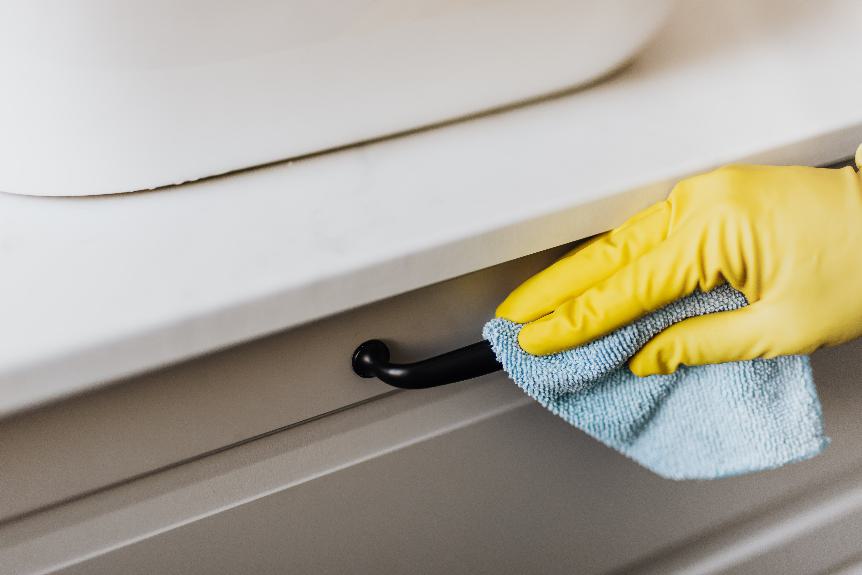Bathroom countertops may turn yellow due to several reasons. Chemicals in cleaning products can react with the countertop materials, causing discoloration. UV light from the sun can fade and change the color of the surfaces. Mineral deposits from hard water can stain the countertops yellow.
As countertops age, materials like natural stone or resin may naturally change color. The combination of heat and moisture in bathrooms can speed up these processes.
It's important to recognize these factors to keep bathroom countertops looking their best.
Chemical Exposure Causes
Bathroom countertops can turn yellow due to chemical reactions from frequent use of cleaning products, such as bleach. These products, while important for cleaning, can damage the surface if used excessively or incorrectly. Countertops, often made of absorbent materials, can soak up substances like bleach, leading to a breakdown of the sealant or the material, causing a yellow tint. This discoloration can worsen when bleach is mixed with other cleaners, which may strip protective finishes or change the material's color.
Repeated use of high-concentration bleach is a typical reason for yellow stains, but even regular use of diluted bleach can cause yellowing over time. It is important to follow the recommended guidelines for both cleaning products and countertop materials to avoid discoloration. Using milder cleaning solutions can help maintain the appearance and condition of the countertops.
Effects of Sunlight
Extended sun exposure can cause bathroom countertops, particularly marble, to yellow faster. UV rays from the sun can break down chemical bonds in these materials, resulting in discoloration. Porous materials like marble absorb UV rays more easily, which can lead to a quicker degradation and a pronounced yellow tint over time. Even well-maintained countertops can discolor after long periods of natural light exposure.
Areas of countertops that receive more sunlight are likely to yellow more quickly than shaded areas. To reduce sunlight damage, it is advisable to use window treatments or UV-protective films to limit direct sun exposure on countertops. Regular maintenance and these protective steps can help maintain the appearance and longevity of bathroom countertops.
Water Damage Concerns
Bathroom countertops may turn yellow due to prolonged moisture exposure and mineral deposits from water. This yellowing suggests potential water damage that needs prompt attention.
Water can penetrate porous materials like marble or limestone, causing the material and its sealant to deteriorate. This can lead to more yellowing and might require expensive repairs or replacement.
Hard water, containing minerals such as calcium and magnesium, can worsen yellowing. To prevent water damage, it is important to regularly dry countertops and maintain them properly.
Applying a UV protective coating can help, but it is not a substitute for regular cleaning and drying. In hard water areas, a water softener can reduce mineral buildup.
To prevent yellowing from water damage, it is essential to keep countertops dry and clean them with gentle, non-abrasive cleaners.
Natural Material Aging
Natural stone countertops, such as marble and granite, can yellow over time due to their porous nature. Marble is particularly prone to yellowing because it reacts with acidic substances, while granite is more resilient but can still discolor without proper care.
Sunlight can hasten yellowing, even for stone not in direct light, as aging is inherent to natural stone. To counteract this, regular cleaning with gentle, non-abrasive cleaners is essential. A mix of water and white vinegar can be used for cleaning, but it is important to confirm that vinegar is suitable for your countertop material due to its acidity. Additionally, applying a UV-protective sealant can protect against sun damage.
Understanding your countertop's characteristics is vital for maintenance. Gentle cleaning agents and protection from sunlight slow down aging and help maintain the appearance of bathroom countertops.
Cleaning Product Reactions
Bathroom countertops often turn yellow due to reactions with certain cleaners, commonly bleach. Bleach kills germs but can damage some surfaces, causing yellow stains that worsen with repeated use.
To keep countertops looking new, avoid using bleach and similar harsh chemicals. Use mild, eco-friendly cleaners instead. A cloth dampened with hydrogen peroxide can remove stains and disinfect without causing yellowing. Hydrogen peroxide is safer for both the environment and countertop materials as it breaks down into water and oxygen.
Alternatively, a mix of baking soda and water can form a soft cleaning paste. Apply this paste, let it sit briefly, then gently scrub with a soft brush or cloth. Baking soda cleans effectively without the abrasive damage that leads to yellowing.
Using these methods helps protect countertops from discoloration due to cleaning products.
Impact of Heat and Humidity
Heat and humidity contribute to the yellowing of bathroom countertops by accelerating aging and increasing moisture exposure. These conditions can cause chemical reactions that lead to discoloration, especially in porous materials like marble, which absorb moisture and are prone to staining. The yellowing indicates material degradation.
To prevent and address yellow stains, it is important to maintain good ventilation in the bathroom and perform regular maintenance, such as cleaning and sealing the countertops. This helps protect them from the elements that cause yellowing, preserving their appearance and slowing down the aging process.
Preventative Measures
To prevent yellowing of bathroom countertops, take several steps to reduce discoloration and maintain their condition.
Shield countertops from sunlight by applying UV protective coatings to block damaging rays. Clean regularly with gentle, non-abrasive cleaners to avoid material degradation.
Keep the bathroom dry and ventilated to prevent moisture-related yellowing. After use, promptly dry surfaces with a clean cloth to prevent staining.
Check countertops for damage like cracks or chips and repair promptly to avoid worsening problems. Consider investing in countertops with inherent discoloration resistance when installing or renovating.
Use strong cleaners such as bleach sparingly, and always dilute and rinse thoroughly to avoid countertop damage. Alternatively, a diluted vinegar and water solution can be used for safer, routine cleaning.
These practices will help maintain the appearance of your bathroom countertops over time.





